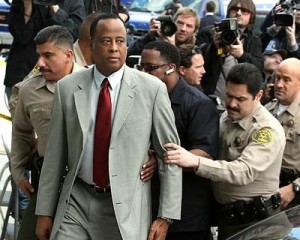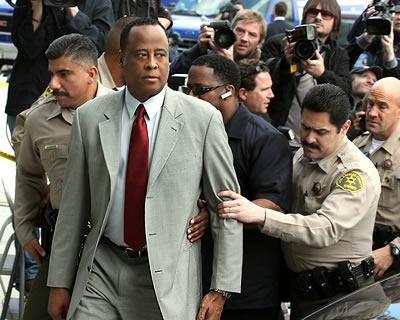
The ongoing trial of
Conrad Murray, Michael Jackson’s former personal physician, has gained extensive media coverage as the prosecution and defense fight for the admission or denial of evidence. Presiding over these lengthy evidentiary hearings is Los Angeles Superior Court Judge Michael E. Pastor,
whose rulings draw close media scrutiny. Given that the courtroom seats had to be
distributed by lottery to present a fair opportunity for the public to observe the proceedings, Judge Pastor faces an unusual atmosphere in which fans essentially become advocates, duly observing each stage of the trial.
Jackson suffered cardiac arrest after ingesting a lethal amount of propofol, a type of anesthesia traditionally administered in a hospital with careful monitoring. Murray faces involuntary manslaughter charges for what the prosecution describes as up to
seventeen “egregious” violations of the standard of care, each of which, they allege, could have contributed directly to Jackson’s death. Meanwhile, the defense argues that Jackson suffered from insomnia and withdrawal from the painkiller Demerol, which compounded with the exhaustion of preparing for his upcoming world tour. Murray contends he administered propofol at Jackson’s request, and claims he complied because he intended to “wean” Jackson off of the drug.
Judge Pastor recently allowed the prosecution to admit
photos of Jackson’s body moments after his death, and after the autopsy. In this summer’s highly publicized
trial of Casey Anthony, who was charged with murdering her four-year-old daughter, prosecutors attempted to introduce autopsy photos of the child, but the judge ruled such evidence prejudicial and prohibited the pictures. In this case, the prosecution contended that the Jackson photos are not prejudicial, not gruesome, and not gory.
Judge Pastor agreed. Regardless, the photo allegedly moved people to tears, and led at least one person to
leave the room.
Aside from the defense’s worry that the admission of such evidence will unfairly prejudice the jury, a secondary issue is
the decedent’s right to privacy. While much of America cringed as Jackson’s family released
This Is It (which grossed more than
$200 million at the box office) soon after his death, the video at least portrayed the musician as an icon. Over the years, Jackson has been the target of tremendous negative media attention regarding his numerous plastic surgeries, a skin condition that drastically changed his pigmentation, and the charges filed against him for molestation. Jackson tried to keep his life private, and it isn’t a stretch to assume that he wouldn’t have wanted pictures of his dead body to be released to the public.
However,
no such law protecting his right to privacy after death yet exists. A similar concept, the “right of publicity,” deals with commercial control over identities (i.e., whether a former icon’s image can be used in a commercial, or whether a combination of items intended to represent a celebrity can legally be sold as a costume). However, this right only extends to living persons who “own” the decedent’s “right to publicity”:
“… a right of publicity that continues after death does little to protect the reputations of the deceased. American law, unlike that in much of Europe, explicitly and uniformly provides that reputational protections – including libel and slander and the right of privacy – all end at death. The expansion of the right of publicity does nothing to change this.”
Catsouras v. Department of California Highway Patrol (2010) is the closest “right to privacy” case dealing with photos of a decedent’s body. In that case, family members of the decedent sued California Highway Patrol officers who
allegedly distributed photographs of the decedent’s corpse to members of the public. The California Court of Appeals held that the family members had a privacy interest in the accident scene photographs. However, two glaring differences distinguish the pictures released in
Catsouras from the photos of Jackson’s body released to the media: In
Catsouras, the circumstances of the decedent’s death was not the subject of a trial, and the decedent was not a public figure. Regardless of the necessity of fair and open trials, and the media’s right to facilitate that interest, one has to wonder whether the distribution of Jackson’s photos only serves to validate and encourage the public’s morbid fascination with Jackson’s life and death.
Of course, it is easy to look back to cases and speculate about whether the jury would have reached a different (or the same) verdict if the judge had allowed or withheld pieces of evidence that, to the media and the public in hindsight, seem key to the outcome of a trial. Judge Pastor has decided that Jackson’s autopsy photos are relevant and valuable to this trial. However, there is something acutely unsettling about the fact that Jackson, who spent a lot of his life trying to escape intense public scrutiny and the media’s invasion of his private life, now has photos of his naked body plastered on
celebrity gossip websites.

 The ongoing trial of Conrad Murray, Michael Jackson’s former personal physician, has gained extensive media coverage as the prosecution and defense fight for the admission or denial of evidence. Presiding over these lengthy evidentiary hearings is Los Angeles Superior Court Judge Michael E. Pastor, whose rulings draw close media scrutiny. Given that the courtroom seats had to be distributed by lottery to present a fair opportunity for the public to observe the proceedings, Judge Pastor faces an unusual atmosphere in which fans essentially become advocates, duly observing each stage of the trial.
Jackson suffered cardiac arrest after ingesting a lethal amount of propofol, a type of anesthesia traditionally administered in a hospital with careful monitoring. Murray faces involuntary manslaughter charges for what the prosecution describes as up to seventeen “egregious” violations of the standard of care, each of which, they allege, could have contributed directly to Jackson’s death. Meanwhile, the defense argues that Jackson suffered from insomnia and withdrawal from the painkiller Demerol, which compounded with the exhaustion of preparing for his upcoming world tour. Murray contends he administered propofol at Jackson’s request, and claims he complied because he intended to “wean” Jackson off of the drug.
Judge Pastor recently allowed the prosecution to admit photos of Jackson’s body moments after his death, and after the autopsy. In this summer’s highly publicized trial of Casey Anthony, who was charged with murdering her four-year-old daughter, prosecutors attempted to introduce autopsy photos of the child, but the judge ruled such evidence prejudicial and prohibited the pictures. In this case, the prosecution contended that the Jackson photos are not prejudicial, not gruesome, and not gory. Judge Pastor agreed. Regardless, the photo allegedly moved people to tears, and led at least one person to leave the room.
Aside from the defense’s worry that the admission of such evidence will unfairly prejudice the jury, a secondary issue is the decedent’s right to privacy. While much of America cringed as Jackson’s family released This Is It (which grossed more than $200 million at the box office) soon after his death, the video at least portrayed the musician as an icon. Over the years, Jackson has been the target of tremendous negative media attention regarding his numerous plastic surgeries, a skin condition that drastically changed his pigmentation, and the charges filed against him for molestation. Jackson tried to keep his life private, and it isn’t a stretch to assume that he wouldn’t have wanted pictures of his dead body to be released to the public.
However, no such law protecting his right to privacy after death yet exists. A similar concept, the “right of publicity,” deals with commercial control over identities (i.e., whether a former icon’s image can be used in a commercial, or whether a combination of items intended to represent a celebrity can legally be sold as a costume). However, this right only extends to living persons who “own” the decedent’s “right to publicity”:
The ongoing trial of Conrad Murray, Michael Jackson’s former personal physician, has gained extensive media coverage as the prosecution and defense fight for the admission or denial of evidence. Presiding over these lengthy evidentiary hearings is Los Angeles Superior Court Judge Michael E. Pastor, whose rulings draw close media scrutiny. Given that the courtroom seats had to be distributed by lottery to present a fair opportunity for the public to observe the proceedings, Judge Pastor faces an unusual atmosphere in which fans essentially become advocates, duly observing each stage of the trial.
Jackson suffered cardiac arrest after ingesting a lethal amount of propofol, a type of anesthesia traditionally administered in a hospital with careful monitoring. Murray faces involuntary manslaughter charges for what the prosecution describes as up to seventeen “egregious” violations of the standard of care, each of which, they allege, could have contributed directly to Jackson’s death. Meanwhile, the defense argues that Jackson suffered from insomnia and withdrawal from the painkiller Demerol, which compounded with the exhaustion of preparing for his upcoming world tour. Murray contends he administered propofol at Jackson’s request, and claims he complied because he intended to “wean” Jackson off of the drug.
Judge Pastor recently allowed the prosecution to admit photos of Jackson’s body moments after his death, and after the autopsy. In this summer’s highly publicized trial of Casey Anthony, who was charged with murdering her four-year-old daughter, prosecutors attempted to introduce autopsy photos of the child, but the judge ruled such evidence prejudicial and prohibited the pictures. In this case, the prosecution contended that the Jackson photos are not prejudicial, not gruesome, and not gory. Judge Pastor agreed. Regardless, the photo allegedly moved people to tears, and led at least one person to leave the room.
Aside from the defense’s worry that the admission of such evidence will unfairly prejudice the jury, a secondary issue is the decedent’s right to privacy. While much of America cringed as Jackson’s family released This Is It (which grossed more than $200 million at the box office) soon after his death, the video at least portrayed the musician as an icon. Over the years, Jackson has been the target of tremendous negative media attention regarding his numerous plastic surgeries, a skin condition that drastically changed his pigmentation, and the charges filed against him for molestation. Jackson tried to keep his life private, and it isn’t a stretch to assume that he wouldn’t have wanted pictures of his dead body to be released to the public.
However, no such law protecting his right to privacy after death yet exists. A similar concept, the “right of publicity,” deals with commercial control over identities (i.e., whether a former icon’s image can be used in a commercial, or whether a combination of items intended to represent a celebrity can legally be sold as a costume). However, this right only extends to living persons who “own” the decedent’s “right to publicity”:

